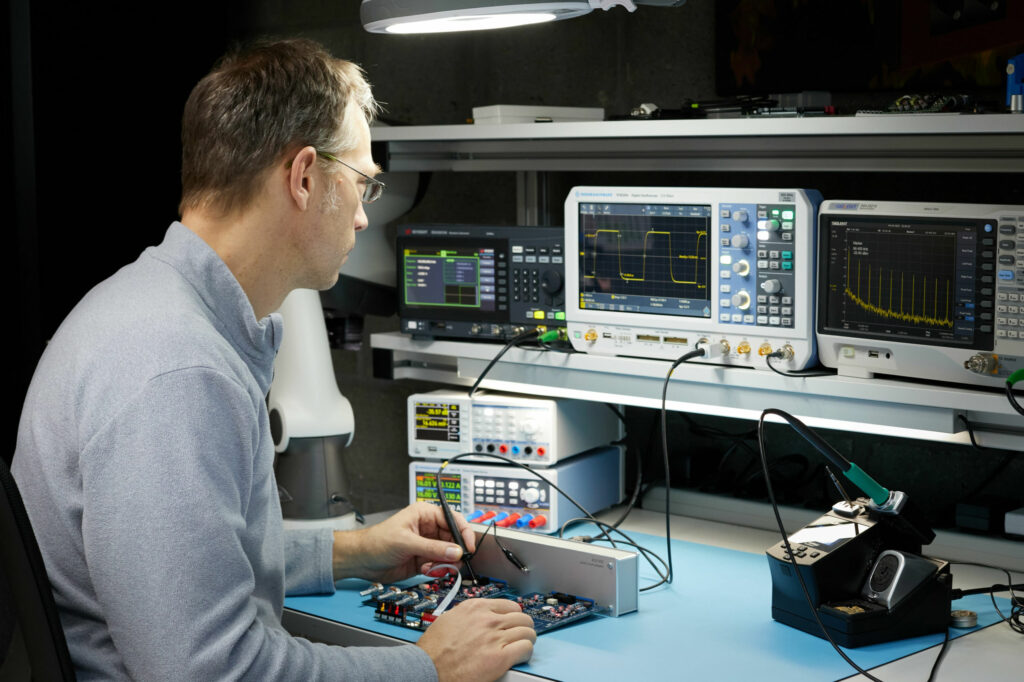
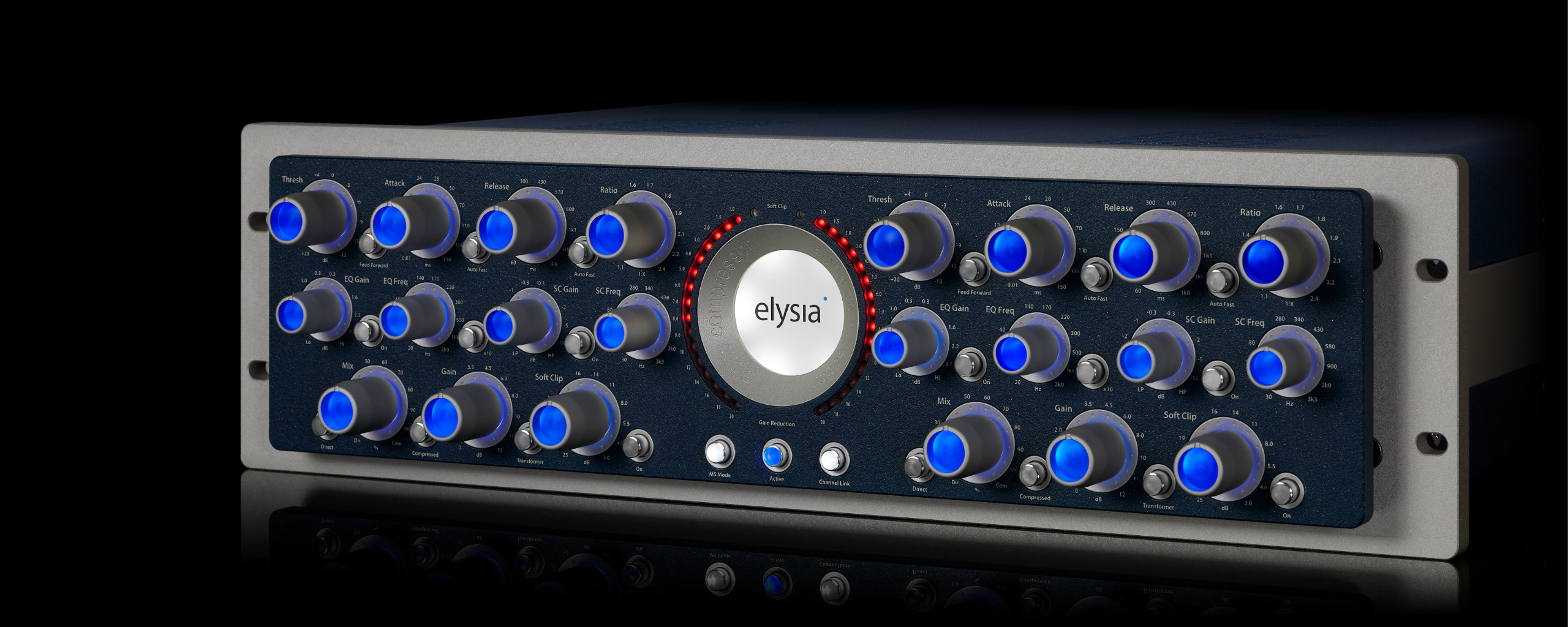

By loading the video, you agree to YouTube's privacy policy.
Learn more

By loading the video, you agree to YouTube's privacy policy.
Learn more
alpha compressor is a professional audio tool to master your audio files. Hear for yourself what alpha compressor can do to your mix! Choose between different examples including applications like mixing or mastering, use good headphones or speakers. Just press Play and A/B between the bypassed and active sounds!
Note: All audio is being processed by the analog hardware device.
Featured artists in these examples: Schutzschall, Living Pearls
Note: If you have technical difficulties and don't hear audio playing back, you may want to switch off silent mode on your mobile device.
This function makes it possible to switch the feed of the sidechain alternatively behind (feedback) or in front (feed forward) of the actual compressor section.
It has an enormous effect on the character of the compressor: While processing in feedback mode is smooth and even, switching into feed forward mode will result in a clearly stronger and harder kind of compression.
From the technical point of view this function mainly influences the characteristic curve of the ratio value. In feedback mode it goes up to a moderate ratio of 1:2.5. In contrast, the feed forward mode provides much higher values which also allow limiter settings and even negative ratios (i.e. loud signals will be reduced even more).
Attack and release are very crucial factors for the operations of a compressor. Choosing the right time settings is very important, but depending on the dynamic progress of the source material this can be a difficult task.
If a very short attack time is chosen, the compressor is able to catch the short peaks, but on the other hand the sustaining signal will also be processed, which might result in audible distortion. Longer settings reduce distortion significantly, but then the compressor is too slow for catching fast impulses.
For example, if you set the attack to 80 ms and then engage the Auto Fast mode, the attack time will be shortened automatically on fast and loud signal impulses. The compressor reduces the signal quickly and prevents it from slipping through.
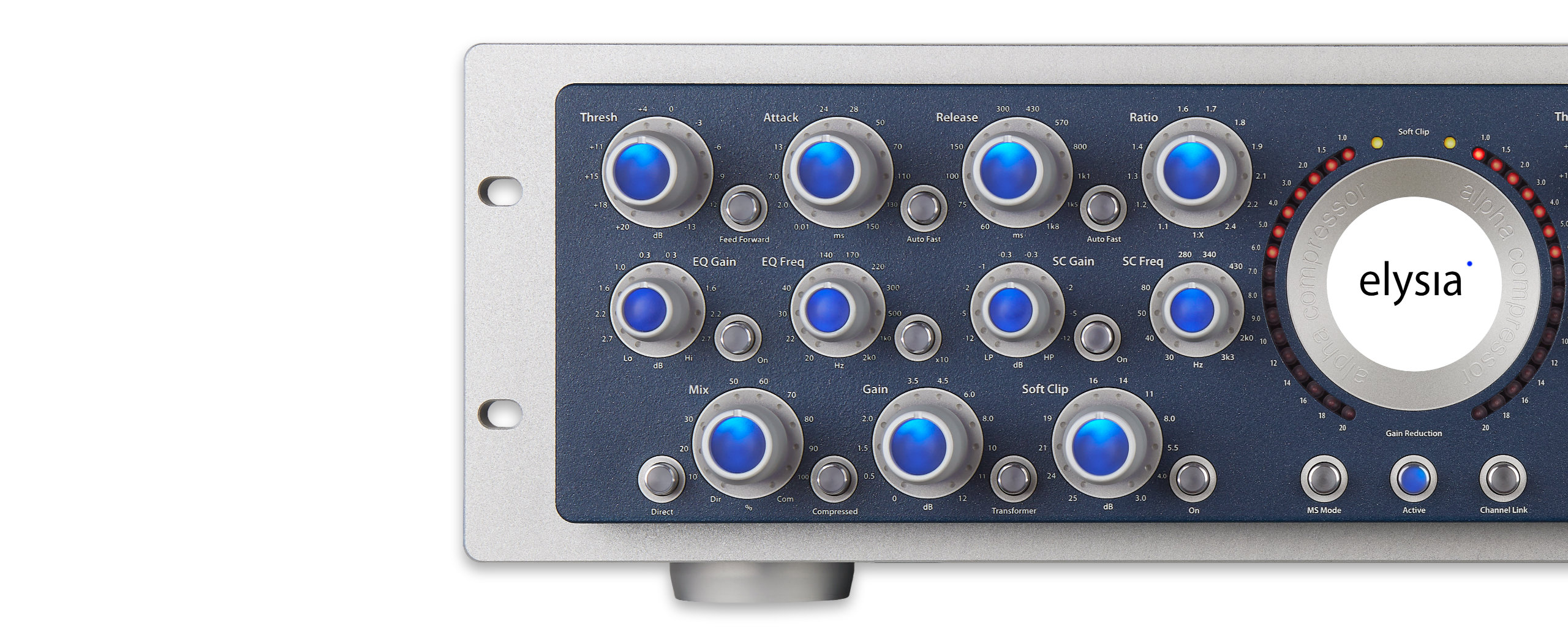
This filter specialized in changing the overall sonic character of a track in fine nuances. It features two controllers per channel and is capable of flexibly producing convincing results in no time at all. Whenever a classic shelving filter would be too limited and a fully parametric filter would be too much, the Niveau Filter is the efficient and elegant solution.
Its main task is changing the proportions between high and low frequencies. It works like a pair of scales: Dependent on the gain setting around a selectable center frequency, the high frequencies are boosted up to +3 dB while the low frequencies are simultaneously attenuated by -5 dB maximum. Turning the gain controller into the other direction will cut the treble and boost the bass instead.
Because the filtered signal is mixed to the original, the genuine structure and impulse-response remains almost completely intact. None of the amplifiers is shortened in its frequency response, resulting in an open and dynamic sound. Boosting and cutting the selected frequency-areas at the same time makes it much easier to influence the character of a track (‘bright’ vs. ‘dark’) than with standard equalizers.
The main advantage of this technology is its mono compatibility. FM radio stations use M/S technology for transmitting stereo signals exactly for this reason.
To create M/S signals, the left and right channel of the stereo sum are added to generate the mid (M), whereas the side (S) is created by subtracting the right from the left channel:
M = L + R
S = L – R
To decode an M/S signal back into stereo again, M is added to S for the left channel and S is subtracted from M for the right channel:
L = M + S
R = M – S
The integration of an M/S encoder and decoder into a compressor generates new potentials that classic linked stereo compressors can hardly offer. The stereo width can be influenced fast and effectively, too, and it is also possible to compress specific parts of a mix that could not be selected in a stereo mix as precisely as it is possible in M/S mode.
One of the biggest problems of digital audio technology is setting the right recording level on AD converters. The main challenge is that there is no level reserve beyond the maximum of 0 dBFS which could catch short peaks. In the moment a signal is digitally overdriven it is damaged irrevocably, because the original structure can hardly be reconstructed later.
Depending on the source signal, this type of peaks will produce audible distortion, as the signal is cut off and does not correspond to the original source anymore. In addition, this kind of clipping produces lots of new harmonics that do not always fit into the desired musical context.
The Soft Clip limiter has been developed to solve these specific problems. It is specialized in catching short and transient-like signals reliably. The technical principle is different from a classic ‘brickwall’ design which completely forbids further level increases beyond a certain threshold.
Instead, it is working similar to an analog tape machine driving loud impulses into saturation, acting like a ‘natural’ limiter. The Soft Clip limiter is based on discrete transistors, and just as with tape, its characteristic saturation curve results in rounding peaks instead of cutting them off.
The alpha compressor uses elysia’s fully discrete and temperature compensated Passive Current Attenuator (PCA). This circuit transforms the incoming signal into a current which is then reduced controlled by voltage. The triggering can be compared to that of a VCA with a predictable characteristic curve. The core consists of sixteen discrete transistors which are kept at a defined temperature by an exclusive heating system, avoiding unwanted fluctuations.
Unlike industrial ICs, the PCA works purely passive – it has no internal amplifiers and only reduces incoming signals. Not until the signal leaves the PCA, a downstream amplifier stage converts the current into voltage again, and the make up gain is added by a separate stage. The characteristic curve of the control voltage has been optimized for mastering applications, resulting in precise but gentle gain reduction performance.
Further advantages of the PCA are its enormous bandwidth and its extremely fast control speed. The PCA plays an important role in the overall sonic character of the alpha compressor. It enriches the music with natural overtones by producing a healthy amount of K2 and K3. The sound becomes richer in character and inspires especially digitally mixed productions with that certain something.
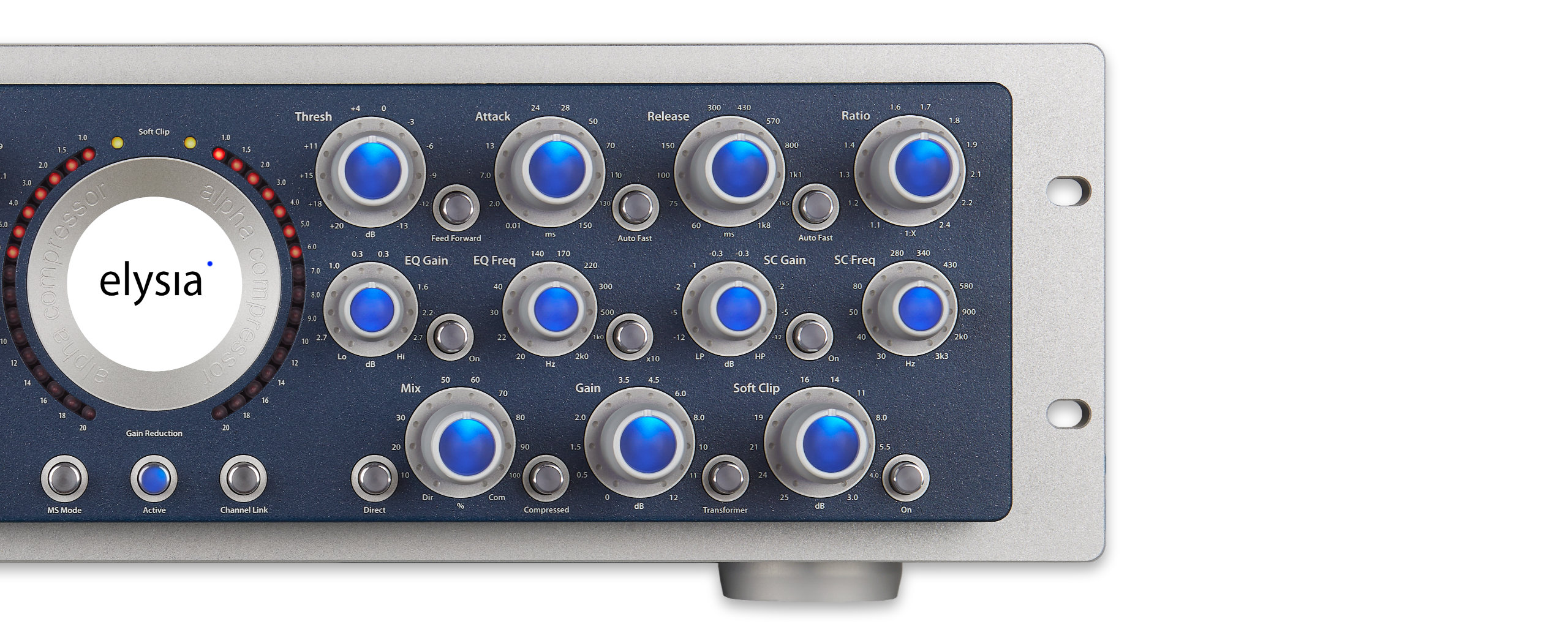
Parallel compression, also known as “New York“ compression, is a technique based on mixing a dry signal with a heavily compressed identical signal.
It is thought to maintain the subtleties of a performance while stabilizing the dynamics.
The mix controller of the alpha compressor makes it possible to cross-fade between the unprocessed and the compressed and filtered signals. This allows parallel compression right in the box and supersedes additional routings in favor of a better signal quality.
Now you can use even extreme compression settings without killing a track by winning the loudness war. By mixing just a part of the compressed signal to the original, the major portion of the initial dynamic structure remains intact.
Some delicate circuit components can be influenced by the surrounding temperature easily. The main reason for this circumstance is the discrete transistors that can react very sensitively to variations in temperature.
With the T16 Heater elysia presents a system that keeps constant conditions and reduces thermal fluctuation to a minimum. It features up to 16 discrete transistors in a massive copper ring which is warmed up to a definite temperature. A cap isolates the copper ring and keeps it from cooling down quickly and prevents heat emission into the housing at the same time.
An electronic control circuit is responsible for only a small variance of just a few degrees. The procedure is known from high end tube gear: the alpha compressor should be granted an adequate warm-up-time in order to experience it in its best form.
The alpha compressor features high-quality conductive plastic potentiometers for all its parameters throughout. The 21 steps make a precise recall very easy, which is very convenient not only for mastering purposes.
Moreover, these potentiometers are also considered to be the best for audio in terms of sound quality. In order to keep the component tolerance as low as possible, we measure all potentiometers and match them as stereo pairs with a software routine we have written exactly for this purpose. The obvious benefit of this effort is that the left and the right channel behave exactly the same.
Through this optimization step, it may happen that some potentiometers feel slightly different, since different values are used.
The sidechain filter allows frequency-dependent shaping of the compression process by giving specific frequency areas a stronger or weaker influence on the detection circuit.
If the SC gain controller is set to HP (High Pass), the filter will act like a 6 dB high pass and the reaction of the compressor on bass frequencies decreases. The setting LP (Low Pass) turns the filter into a 6 dB low pass and the compressor reacts primarily on low frequencies.
The combination of the sidechain filters, M/S matrix and different attack settings enables you to make very selective changes and – depending on the source material – even allows to process single instruments or voices in finished mixes.
Every single of its many aspects – sound, features, circuitry, components, design, materials, manufacturing – has been thought over and over until there was just nothing left to improve. Basically, every single part of this fine compressor is custom, and most of these are made according to our own designs and specs.
Only the best components the market has to offer are good enough for the alpha, and it shows. Each alpha compressor is manually built to order and tested by ourselves, here at our headquarters in Germany.
The alpha’s benefits sum up in an audio quality that is beyond all doubt. Even when extreme settings are used, the sound always stays clean and powerful. The alpha achieves perfect processing results for all different styles of music and assures the ‘this is it’ feeling of a finished song. Its enhanced functions exceed the potential of normal compressors by far and give you unimagined options for mastering and mixing.
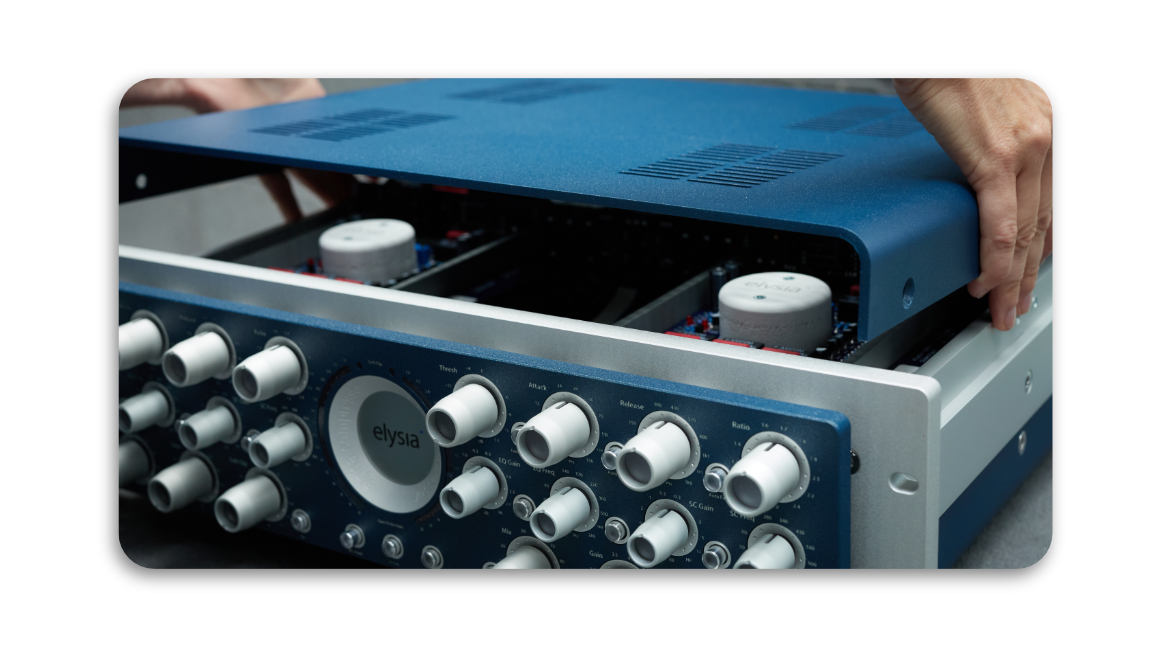
The alpha compressor plugin license includes two separate versions optimized for specific tasks. This way, you can always choose the user interface that just works best for you.
The mastering version is the exact representation of the original hardware with all its bells and whistles, including Mid/Side operation, the Niveau Filter section, the Soft Clip limiter and the clever Signal Matrix.
The mixing version focuses on the actual compression section, and by doing so it gives you amazing results without having to spend much thought on the process. Actually, you might want to use this on every single track of your DAW.

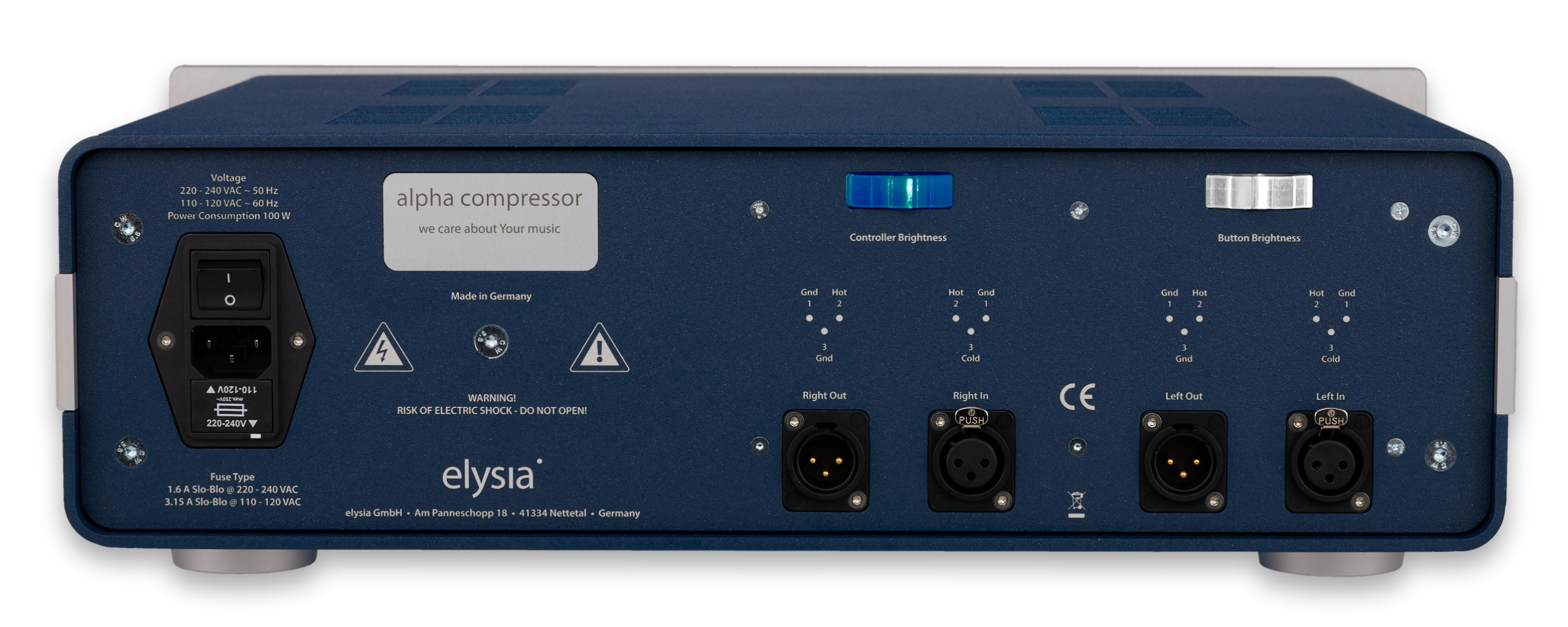
The back of alpha compressor is a piece of art – just like the front. Connecting to alpha compressor is made very easy. As a true stereo device, there are main XLR inputs and outputs for the left and right channel with a handy Pin-out pattern for balanced and unbalanced cables.
A small but useful detail is the separate built-in brightness control for the blue and white LEDs on the front panel for the control knobs, buttons and the logo. So you can adjust the lighting of alpha compressor to your studio environment.
The mains module combines the line cord connector, the on/off switch, the fuse holder with integrated 230/115 VAC voltage selector and a line filter for providing the transformer with clean current.
Frequency response:
<10 Hz – 200 kHz (-0,5 dB)
THD+N @ +15 dBu, 20 Hz – 22 kHz:
Stereo Mode (Direct):
Stereo Mode (Compressed):
M/S Mode (Direct):
M/S Mode (Compressed):
0,0039 %
0,009 %
0,014 %
0,034 %
Noise floor, 20 Hz – 20 kHz (A-weighted):
Stereo Mode (Direct):
Stereo Mode (Compressed):
M/S Mode (Direct):
M/S Mode (Compressed):
-95,8 dBu
-89,3 dBu
-95,6 dBu
-92,3 dBu
Dynamic range, 20 Hz – 22 kHz:
Stereo Mode:
M/S Mode:
122 dB
118 dB
Maximum input level:
Stereo Mode:
M/S Mode:
+28 dBu
+23 dBu
Maximum output level:
Stereo Mode:
M/S Mode:
+27 dBu
+28 dBu
Impedance:
Input:
Output:
10 kOhm
68 Ohm
Dimensions (W x H x D, incl. Knobs):
19” x 5,3“ x 16“
483 mm x 133 mm x 405 mm
Weight:
35 lbs / 16 kg
Power consumption:
85 Watts
Potentiometers:
21 Steps
Unlock the true potential of your audio productions with the elysia alpha compressor. Designed with meticulous attention to detail, this industry-leading compressor empowers you to achieve exceptional results in both mixing and mastering.
The alpha compressor provides unparalleled control over your audio dynamics. Whether you’re looking to subtly enhance the character of individual tracks or achieve punchy and transparent dynamics on your final mix, this compressor delivers pristine results every time.It brings a new level of depth, clarity, and coherence to your mixes. With its intelligent processing capabilities, it effortlessly tames unruly peaks, balances dynamics, and adds rich warmth and thickness to your tracks. Take your mixes from ordinary to extraordinary with ease.
The power of mastering: Designed with mastering engineers in mind, the alpha compressor boasts an array of features tailored specifically to optimize your mastering workflow. Achieve impeccable stereo imaging, precise transient shaping, and detailed dynamic control to ensure your final masters are sonically impressive and competitive. The alpha compressor not only excels at transparent compression, but also invites you to explore new creative possibilities. Its unique features, such as the innovative M/S mode and the Mix knob for parallel compression, enable you to experiment and sculpt your sound to perfection, adding that touch of magic that sets your mixes apart.
Crafted for professionals, loved by artists: Trusted by top audio engineers and sought after by renowned artists, the elysia alpha compressor is the ultimate tool for achieving professional-grade mixes and masters. Its rugged build quality, intuitive interface, and unmatched sonic performance make it the go-to choice for studios worldwide.
Copyright @ 2024 elysia GmbH. All rights reserved. Am Panneschopp 18 | 41334 Nettetal | business hours from monday until friday from 9:00 to 17:00h (CET)
We need your consent before you can continue on our website. If you are under 16 and wish to give consent to optional services, you must ask your legal guardians for permission. We use cookies and other technologies on our website. Some of them are essential, while others help us to improve this website and your experience. Personal data may be processed (e.g. IP addresses), for example for personalized ads and content or ad and content measurement. You can find more information about the use of your data in our privacy policy. You can revoke or adjust your selection at any time under Settings.
If you are under 16 and wish to give consent to optional services, you must ask your legal guardians for permission. We use cookies and other technologies on our website. Some of them are essential, while others help us to improve this website and your experience. Personal data may be processed (e.g. IP addresses), for example for personalized ads and content or ad and content measurement. You can find more information about the use of your data in our privacy policy. Here you will find an overview of all cookies used. You can give your consent to whole categories or display further information and select certain cookies.